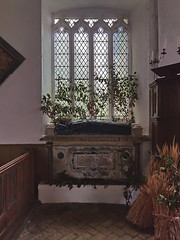| |
Shelley isn't just
a pretty name, it's a lovely place. But if you want to
see it you will need to find it first, for it must be
among the most remote of all Suffolk villages,
particularly when approached from the south and west. No
major road goes anywhere near, and coming down from
Withermarsh Green in the hills, you reach a simple street
hugging the River Brett which gently bottoms out here.
Houses are old and scattered, and you could easily miss
the church with its low tower as you take the corner.
The tower stands to the north of the nave - indeed,
because the south aisle extends fully westwards, it
appears to be behind the church. In a rare misreading of
his notes, Mortlock suggests that it is also the main
entrance, but this is not the case; the north side of the
churchyard is hemmed in quite severely, and you enter
directly into the south aisle from a pretty little wood
and brick porch.
The Sanctuary is plain and fitting, Anglican in its
simplicity. Also Anglican is the elegant Elizabethan
pulpit, a rather sturdy example of the wineglass style.
About twenty years ago the friendly churchwarden of the
time informed me that it had 'recently begun to wobble',
so he'd cemented it in more securely. He also showed me
the pieces of an organ in the south aisle, which had come
here from Woodbridge St John. He told me that he'd
brought it over bit by bit in his car, without the least
idea of how to put them together! However, it is now all
in its proper place and in working order.
Many people who come to Shelley will do so to see Dame
Margarett Tylney. Her effigy lies in a window embrasure
to the west of the pulpit - rather unnervingly, a
preacher must look down into her wide-eyed face. It is
strange to think that, from this very same pulpit, a 16th
century Minister could have looked down at her when she
was still alive. She wears a ruff and a black dress, the
very model of Elizabethan piety. She died in 1598,
shortly before the Tudor dynasty ended. She was part of
its last gasp, and barely forty years separate her from
the madness of the Commonwealth and the vandalism of the
Puritans. Quite rightly, she looks from another age.
  
The setting of the
memorial is perhaps a little odd, and it may originally
have been placed in the chancel. An earlier Tylney, Sir
Philip, has his memorial there now. It looks as if it was
intended as an Easter sepulchre, although it is not
complete and may also have been reset here from
elsewhere. As with many of the churches to the south of
Hadleigh, All Saints was thoroughly scoured and reordered
by the Victorians. This is not necessarily a bad thing,
and as much as the Tylney's may have shuffled huffily in
their graves at being shifted about, the restoration left
Shelley with a lovely little village church that is at
once beautiful and dignified, and still todfay in a fine
condition. I'm sure that Dame Margrett would have
approved of that.
Her sleeping effigy was witness to a quite extraordinary
event in the early years of the 21st Century. In 2003,
archeologists working at Jamestown, Virginia in the
United States of America discovered the remains of a body
which had been buried with obvious ceremony at the James
Fort heritage site. There was a theory that it could have
been the corpse of Captain Bartholomew Gosnold, a
Suffolk-born adventurer who led the pioneers that
established the first English colony in the New World at
Jamestown in 1607. A certain amount of DNA was recovered,
and the only way of establishing for certain the identity
of the corpse was to find a match from a source known to
be of the same family. Gosnold's sister Elizabeth Tilney
Gosnold had been buried in the vault of Shelley church,
and permission was given for the vault to be opened and a
DNA sample obtained.
James Halsall, the Diocesan Secretary, explained to the
press at the time that permission was given because of
"the strength of the educational and scientific
rationale presented to us by the Jamestown team".
The Victorian tiles were removed from the chancel floor,
then the 18th Century bricks below them, and then the
17th Century flagstones. A small amount of DNA was
obtained from the corpse of Elizabeth, but it proved not
to be a match. A brass plaque on the chancel wall recalls
the event and remembers Elizabeth.
Simon Knott, October 2020
Follow these journeys as they happen at Last Of England
Twitter.
|
|

